197. Hartlaub's Spurfowl (formerly known as Hartlaub's Francolin) Pternistis hartlaubi (Klipfisant)
Order: Galliformes. Family: Phasianidae
Description
Length: Male 28 cm; female 25 cm. A small, squat bird; both sexes of this species have disproportionately large bills for their size (in comparison to other Spurfowl species). The bare parts are mostly a dull yellow; the large bill is a brownish yellow.
Male: Strong contrast of mottled buff/brown upperparts and white underparts streaked with brown. Black forehead with white eyebrow conspicuous. Black-and-white barred undertail coverts especially diagnostic in flight. The males only have rudimentary spurs.
Female: Like male, but with cinnamon (not white) unstreaked underparts, grey-brown head and orange-brown eyebrow. Lacks undertail barring of male. Juvenile: Buffy forehead and brown crown tinged with rufous. Upperparts buffy grey with black and white vermiculations. Breast barred black and white, with buffy grey belly.
Distribution
Endemic to the escarpment zone of Namibia and Angola. Scattered populations can be found in central and northern Namibia and south-western Angola, in particular along the escarpment from Windhoek to the Kunene River and east to Grootfontein. They are absent from the open plains of Ovamboland.
Habitat
Found where there are rocky outcrops, or scattered boulders.
Diet
Mainly feeds on corns, bulbs, seeds and fruits by scraping them out with their large bills. They also eat insects, grubs and larvae, beetles and land molluscs.
Breeding
Monogamous. Nest a scrape in the ground lined with dry leaves. Usually 3 eggs are laid between April and August with an incubation period of 23 days. Chicks can fly short distances at 3 days. They are fully grown at 165 days.
Call
Pairs call in a squeaky duet at sunrise and sunset eeha-weeha, eeha-ideo, eeha-weeha, eeha-ideo. Listen to Bird Call.
Status
Fairly common, near endemic resident.
Africa Wild Bird Book
Hartlaub's Spurfowl Photos
197. Hartlaub's Spurfowl (formerly known as Hartlaub's Francolin) Pternistis hartlaubi (Klipfisant)
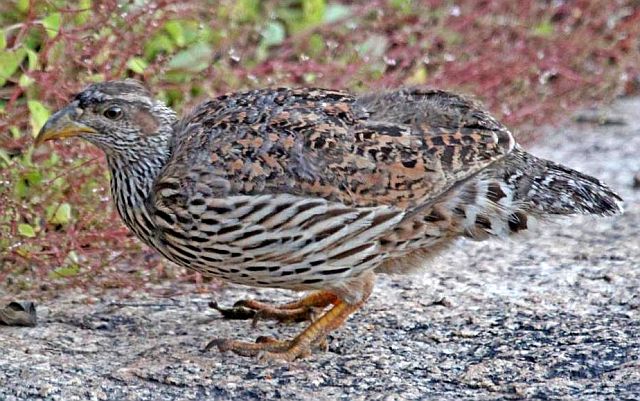
Male
Links:
Species Text Sabap1
Sabap2
Avian Leisure: NAMIBIAN BIRDING DELIGHTS – HARTLAUB’S SPURFOWL

Male
Links:
Species Text Sabap1
Sabap2
Avian Leisure: NAMIBIAN BIRDING DELIGHTS – HARTLAUB’S SPURFOWL
-
Michele Nel
- Posts: 1994
- Joined: Mon Sep 10, 2012 10:19 am
- Country: South Africa
- Location: Cape Town
- Contact:
Red-billed Spurfowl
194. Red-billed Spurfowl Pternistis adspersus (Rooibekfisant)
Order: Galliformes. Family: Phasianidae
Description
35-38 cm. The only francolin in southern Africa with yellow around the eye. This, as well as the combination of dull red bill, red legs, absence of white or red on the throat make identification of this species easy. Finely barred all over.
Plumage of male and female is similar but the male can be distinguished by his long, sharp leg spurs. Female lacks the spurs.
Juvenile lacks the yellow around the eye. Browner than adult; bill and legs brownish.
Distribution
Occurs in northern Namibia, south-western Angola, Botswana, western Zimbabwe and western North West Province.
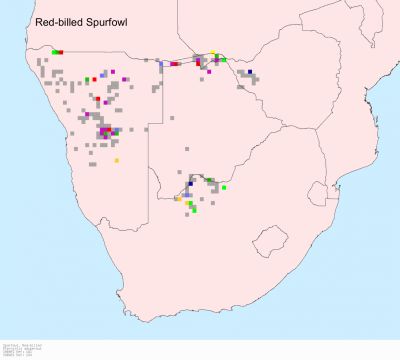
Habitat
Dry savannas.
Diet
Varied diet of bulbs, corms, tubers, fruit and seeds.
Breeding
Monogamous. The breeding season is year round, dependent on rainfall. Usually lays 6-7 eggs in sparsely-lined nest placed among tufts of grass or beneath shrub. After laying 3-10 eggs, the female incubates them for about 22 days before they hatch. Young leave the nest soon after hatching.
Call
Loud, harsh chaa-chaa-chek-chek (similar to Cape and Natal Spurfowls).
Listen to Bird Call.
Status
Common near-endemic.
Order: Galliformes. Family: Phasianidae
Description
35-38 cm. The only francolin in southern Africa with yellow around the eye. This, as well as the combination of dull red bill, red legs, absence of white or red on the throat make identification of this species easy. Finely barred all over.
Plumage of male and female is similar but the male can be distinguished by his long, sharp leg spurs. Female lacks the spurs.
Juvenile lacks the yellow around the eye. Browner than adult; bill and legs brownish.
Distribution
Occurs in northern Namibia, south-western Angola, Botswana, western Zimbabwe and western North West Province.

Habitat
Dry savannas.
Diet
Varied diet of bulbs, corms, tubers, fruit and seeds.
Breeding
Monogamous. The breeding season is year round, dependent on rainfall. Usually lays 6-7 eggs in sparsely-lined nest placed among tufts of grass or beneath shrub. After laying 3-10 eggs, the female incubates them for about 22 days before they hatch. Young leave the nest soon after hatching.
Call
Loud, harsh chaa-chaa-chek-chek (similar to Cape and Natal Spurfowls).
Listen to Bird Call.
Status
Common near-endemic.
-
Michele Nel
- Posts: 1994
- Joined: Mon Sep 10, 2012 10:19 am
- Country: South Africa
- Location: Cape Town
- Contact:
Red-billed Spurfowl Photos
194. Red-billed Spurfowl Pternistis adspersus
Order: Galliformes. Family: Phasianidae

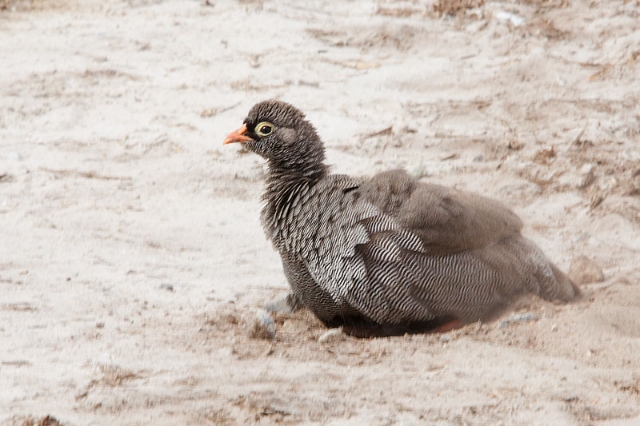 © PRWIN
© PRWIN
Elephant Sands lodge & campsite in the north-eastern part of Botswana
Links:
Sabap2
Biodiversity Explorer
Order: Galliformes. Family: Phasianidae

 © PRWIN
© PRWINElephant Sands lodge & campsite in the north-eastern part of Botswana
Links:
Sabap2
Biodiversity Explorer
-
Michele Nel
- Posts: 1994
- Joined: Mon Sep 10, 2012 10:19 am
- Country: South Africa
- Location: Cape Town
- Contact:
Cape Spurfowl
195. Cape Spurfowl Pternistis capensis (Kaapse Fisant)
Order: Galliformes. Family: Phasianidae
Description
40-43 cm. This spurfowl appears all dark from a distance, but when seen closer the plumage is finely vermiculated in grey and white, with pale cheeks and a the dark cap. Legs and feet dull red. Upper mandible dark, lower mandible dull orange, cere dull yellow.
The sexes are similar in plumage, but the male has two leg spurs whereas the female has at best one short spur. The male is generally larger than the female. Juveniles are similar to the adults, but have duller legs and clearer vermiculation.
Similar species: The only other large, dark francolin within the distribution of the Cape Spurfowl is the Red-necked Spurfowl, which can be easily distinguished by the red skin around the eyes and on the throat. The contrast between the pale cheeks and the dark cap of the Cape Spurfowl distinguishes it from other large dark francolins. The Grey-winged Francolin and Red-winged Francolin are also found within the distribution of the Cape Spurfowl but are much smaller and lighter coloured with completely different feather patterning.
Distribution
Endemic: distribution is concentrated mainly in the Western Cape but extends into Northern Cape, southern Namibia and Eastern Cape.

Habitat
Found mainly in fynbos and karoo but also in gardens and agricultural settings.
Diet
Food consists of insects, snails, ants, fruits, berries, bulbs, seeds and grain.
Breeding
Its nest is a scrape in the ground lined with grass, hidden in or under vegetation. The breeding season is July to January. Laying dates: Eastern Cape: November (1 record); Western Cape: July to January (peak in September); Northern Cape: May (1 record). After laying 4-8 eggs (1 egg laid every second day), the female incubates them for 22-25 days until they hatch. Clutches of more than 8 eggs (14 have been recorded) are thought to be the result of two females laying in the nest. Chicks can fly for short distances after 12 days.
Call
The call is a loud cackalac-cackalac-cackalac.
Spoor

Order: Galliformes. Family: Phasianidae
Description
40-43 cm. This spurfowl appears all dark from a distance, but when seen closer the plumage is finely vermiculated in grey and white, with pale cheeks and a the dark cap. Legs and feet dull red. Upper mandible dark, lower mandible dull orange, cere dull yellow.
The sexes are similar in plumage, but the male has two leg spurs whereas the female has at best one short spur. The male is generally larger than the female. Juveniles are similar to the adults, but have duller legs and clearer vermiculation.
Similar species: The only other large, dark francolin within the distribution of the Cape Spurfowl is the Red-necked Spurfowl, which can be easily distinguished by the red skin around the eyes and on the throat. The contrast between the pale cheeks and the dark cap of the Cape Spurfowl distinguishes it from other large dark francolins. The Grey-winged Francolin and Red-winged Francolin are also found within the distribution of the Cape Spurfowl but are much smaller and lighter coloured with completely different feather patterning.
Distribution
Endemic: distribution is concentrated mainly in the Western Cape but extends into Northern Cape, southern Namibia and Eastern Cape.

Habitat
Found mainly in fynbos and karoo but also in gardens and agricultural settings.
Diet
Food consists of insects, snails, ants, fruits, berries, bulbs, seeds and grain.
Breeding
Its nest is a scrape in the ground lined with grass, hidden in or under vegetation. The breeding season is July to January. Laying dates: Eastern Cape: November (1 record); Western Cape: July to January (peak in September); Northern Cape: May (1 record). After laying 4-8 eggs (1 egg laid every second day), the female incubates them for 22-25 days until they hatch. Clutches of more than 8 eggs (14 have been recorded) are thought to be the result of two females laying in the nest. Chicks can fly for short distances after 12 days.
Call
The call is a loud cackalac-cackalac-cackalac.
Spoor

-
Michele Nel
- Posts: 1994
- Joined: Mon Sep 10, 2012 10:19 am
- Country: South Africa
- Location: Cape Town
- Contact:
Cape Spurfowl Photos
195. Cape Spurfowl Pternistis capensis

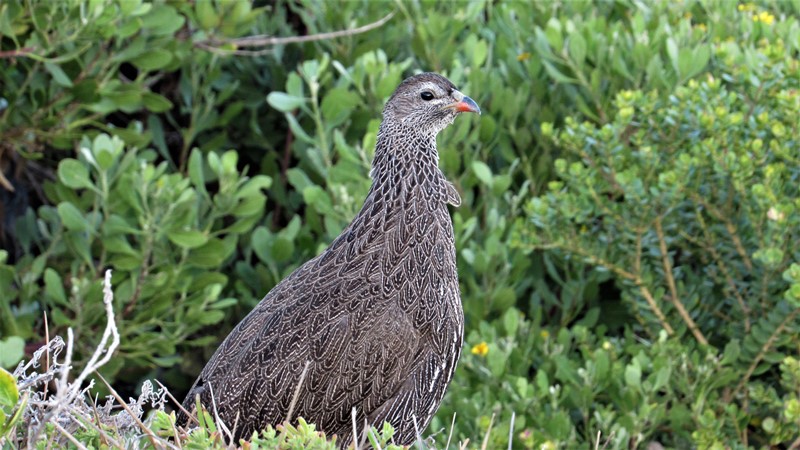
Agulhas National Park © All-Nature
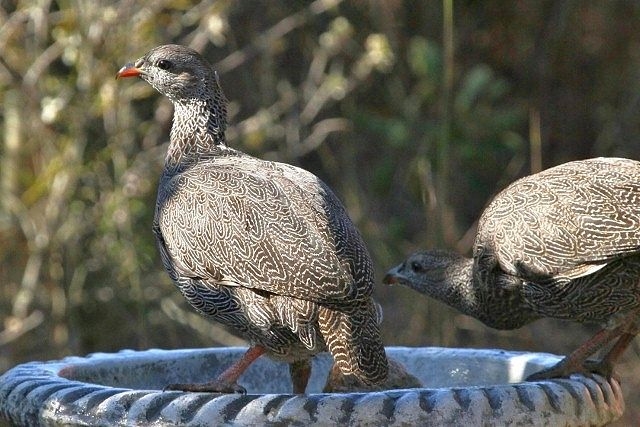 © nan
© nan
 © Lisbeth
© Lisbeth
 © Michele Nel
© Michele Nel
Chick
 © Tina
© Tina
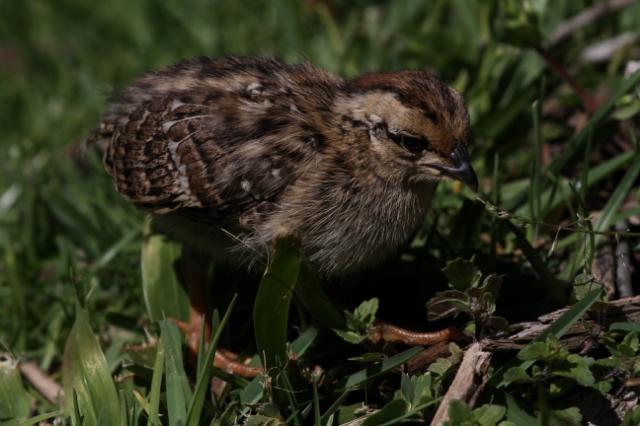 © Tina
© Tina
Kirstenbosch, Cape Town
Links:
Sabap2
Biodiversity Explorer


Agulhas National Park © All-Nature
 © nan
© nan © Lisbeth
© Lisbeth © Michele Nel
© Michele NelChick
 © Tina
© Tina © Tina
© TinaKirstenbosch, Cape Town
Links:
Sabap2
Biodiversity Explorer
- Flutterby
- Posts: 44029
- Joined: Sat May 19, 2012 12:28 pm
- Country: South Africa
- Location: Gauteng, South Africa
- Contact:
Natal Spurfowl
196. Natal Spurfowl Pternistis natalensis (Natalse Fisant)
Order: Galliformes. Family: Phasianidae
Description
Within its range it is the only spurfowl without bare skin around the eyes and on the throat. Red bill with yellow base. Generally brown above and barred and speckled black and white below. Red Legs.
Plumage of male and female is similar. The male is heavier (average weight c 500 g versus c 390 g in female) and has much longer leg spurs than the female.
Juvenile resembles adults but has less speckling below and is darker brown on the breast and back.
Similar species: Similar to the large Red-necked Spurfowl but does not have bare red skin around the eyes and on the throat.
Distribution
Occurs in eastern regions of South Africa, in eastern Botswana, all over Zimbabwe, northern Mozambique and outside of southern Africa it is found in southern Zambia.
Habitat
Wooded habitat, especially thickets of bush along rivers and on hill slopes.
Diet
Winter diet dominated by plant matter such as bulbs, roots, seeds and some fruit, supplemented by insects in summer.
Breeding
Monogamous. Nest a scrape in the ground, lined with grass stems and sometimes feathers, hidden in scrubby vegetation. Breeding season in Zimbabwe is all months (peak March to May); in South Africa: peak December to May. After laying 2-7 eggs, the female incubates them for 20-25 days before they hatch. Chicks can fly short distances after 10-14 days.
Call
A harsh kwali-kwali-kwali.
Listen to Bird Call.
Status
Locally common near-endemic.
Order: Galliformes. Family: Phasianidae
Description
Within its range it is the only spurfowl without bare skin around the eyes and on the throat. Red bill with yellow base. Generally brown above and barred and speckled black and white below. Red Legs.
Plumage of male and female is similar. The male is heavier (average weight c 500 g versus c 390 g in female) and has much longer leg spurs than the female.
Juvenile resembles adults but has less speckling below and is darker brown on the breast and back.
Similar species: Similar to the large Red-necked Spurfowl but does not have bare red skin around the eyes and on the throat.
Distribution
Occurs in eastern regions of South Africa, in eastern Botswana, all over Zimbabwe, northern Mozambique and outside of southern Africa it is found in southern Zambia.
Habitat
Wooded habitat, especially thickets of bush along rivers and on hill slopes.
Diet
Winter diet dominated by plant matter such as bulbs, roots, seeds and some fruit, supplemented by insects in summer.
Breeding
Monogamous. Nest a scrape in the ground, lined with grass stems and sometimes feathers, hidden in scrubby vegetation. Breeding season in Zimbabwe is all months (peak March to May); in South Africa: peak December to May. After laying 2-7 eggs, the female incubates them for 20-25 days before they hatch. Chicks can fly short distances after 10-14 days.
Call
A harsh kwali-kwali-kwali.
Listen to Bird Call.
Status
Locally common near-endemic.
- Flutterby
- Posts: 44029
- Joined: Sat May 19, 2012 12:28 pm
- Country: South Africa
- Location: Gauteng, South Africa
- Contact:
Natal Spurfowl Photos
196. Natal Spurfowl Pternistis natalensis

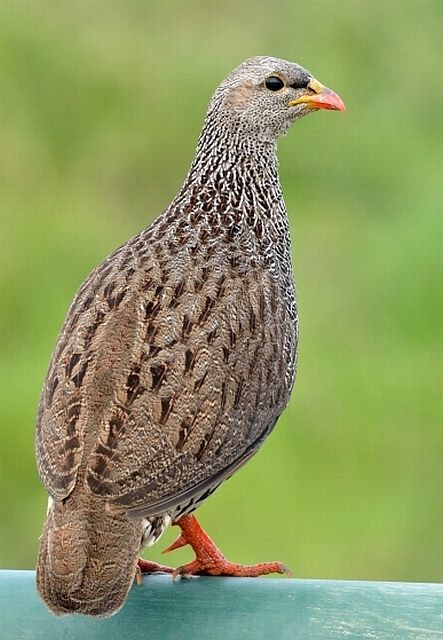 © BluTuna
© BluTuna
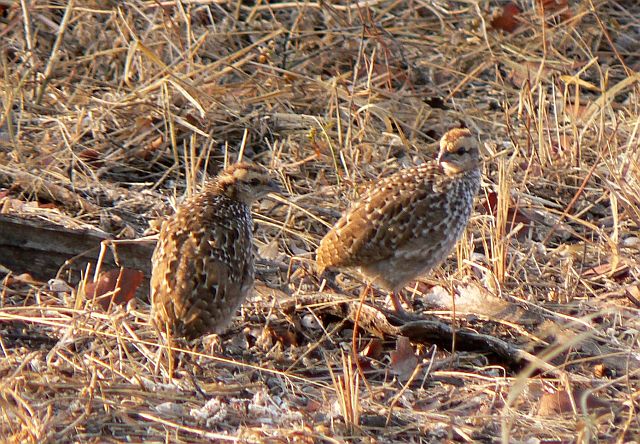 © Toko
© Toko
Kruger National Park, Mopani
 © nan
© nan
Kruger National Park
Links:
http://sabap2.adu.org.za/docs/sabap1/196.pdf
http://sabap2.adu.org.za/spp_summary.ph ... §ion=3

 © BluTuna
© BluTuna © Toko
© TokoKruger National Park, Mopani
 © nan
© nanKruger National Park
Links:
http://sabap2.adu.org.za/docs/sabap1/196.pdf
http://sabap2.adu.org.za/spp_summary.ph ... §ion=3
-
Michele Nel
- Posts: 1994
- Joined: Mon Sep 10, 2012 10:19 am
- Country: South Africa
- Location: Cape Town
- Contact:
Red-necked Spurfowl
198. Red-necked Spurfowl Pternistis afer (Rooikeelfisant)
Order: Galliformes. Family: Phasianidae
Description
25–38 cm. The only spurfowl in southern Africa with red bill, red around the eyes, red throat and red legs. Dark, brown above. The black streaking on the flanks against a silvery/grey/white background is also distinctive.
Male and female plumage similar. The male can be distinguished by have 1-2 long, sharp leg spurs. Juveniles lack the red throat and have chestnut edging on the feathers.
Similar species: Swainson's Spurfowl is similar in that it has red around the eyes and red throat but differs in having a black bill and blackish-brownish legs.
Distribution
Occurs from Grootvadersbos (east of Swellendam in the Western Cape), up through the Eastern Cape, inland regions of KwaZulu-Natal, Mpumalanga, southern Limpopo Province, Mozambique and eastern Zimbabwe. Beyond southern Africa it occurs in parts of East Africa, Central Africa and over most of Angola.
Subspecies:
P. a. cranchii n Gabon and s Congo Republic through s, e DR Congo to c Angola and w Zambia to c Tanzania, w Kenya and Uganda
P. a. afer w Angola and nw Namibia
P. a. castaneiventer s, e South Africa
P. a. humboldtii se Kenya and n, e Tanzania to Mozambique, ne Zambia and e Zimbabwe
Habitat
Found where there is dense cover such as along forest and river edges.
Diet
Primarily tubers, bulbs, roots, fruits and green shoots supplemented by insects in winter.
Breeding
Monogamous. Nest a scrape in the ground, lined with grass and a few feathers, and hidden among vegetation. Breeding season (laying dates): variable, depending on rainfall but mainly November to April. The female lays 4 to 7 eggs which are yellowish in colour. The female incubates them for about 23 days before they hatch. Young are almost fully grown by 3-4 months.
Call
Harsh krr krr krr korwa korwa korwa. When disturbed and taking flight the call is a very loud kêk, kêk, kêk.
Listen to Bird Call.
Status
Uncommon to locally common resident.
Order: Galliformes. Family: Phasianidae
Description
25–38 cm. The only spurfowl in southern Africa with red bill, red around the eyes, red throat and red legs. Dark, brown above. The black streaking on the flanks against a silvery/grey/white background is also distinctive.
Male and female plumage similar. The male can be distinguished by have 1-2 long, sharp leg spurs. Juveniles lack the red throat and have chestnut edging on the feathers.
Similar species: Swainson's Spurfowl is similar in that it has red around the eyes and red throat but differs in having a black bill and blackish-brownish legs.
Distribution
Occurs from Grootvadersbos (east of Swellendam in the Western Cape), up through the Eastern Cape, inland regions of KwaZulu-Natal, Mpumalanga, southern Limpopo Province, Mozambique and eastern Zimbabwe. Beyond southern Africa it occurs in parts of East Africa, Central Africa and over most of Angola.
Subspecies:
P. a. cranchii n Gabon and s Congo Republic through s, e DR Congo to c Angola and w Zambia to c Tanzania, w Kenya and Uganda
P. a. afer w Angola and nw Namibia
P. a. castaneiventer s, e South Africa
P. a. humboldtii se Kenya and n, e Tanzania to Mozambique, ne Zambia and e Zimbabwe
Habitat
Found where there is dense cover such as along forest and river edges.
Diet
Primarily tubers, bulbs, roots, fruits and green shoots supplemented by insects in winter.
Breeding
Monogamous. Nest a scrape in the ground, lined with grass and a few feathers, and hidden among vegetation. Breeding season (laying dates): variable, depending on rainfall but mainly November to April. The female lays 4 to 7 eggs which are yellowish in colour. The female incubates them for about 23 days before they hatch. Young are almost fully grown by 3-4 months.
Call
Harsh krr krr krr korwa korwa korwa. When disturbed and taking flight the call is a very loud kêk, kêk, kêk.
Listen to Bird Call.
Status
Uncommon to locally common resident.
-
Michele Nel
- Posts: 1994
- Joined: Mon Sep 10, 2012 10:19 am
- Country: South Africa
- Location: Cape Town
- Contact:
Red-necked Spurfowl Photos
198. Red-necked Spurfowl Pternistis afer
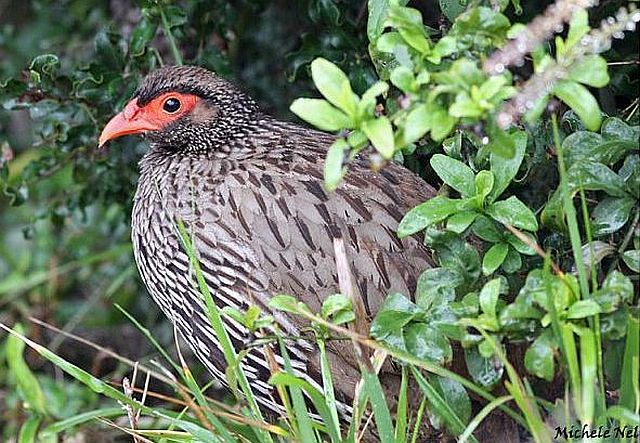
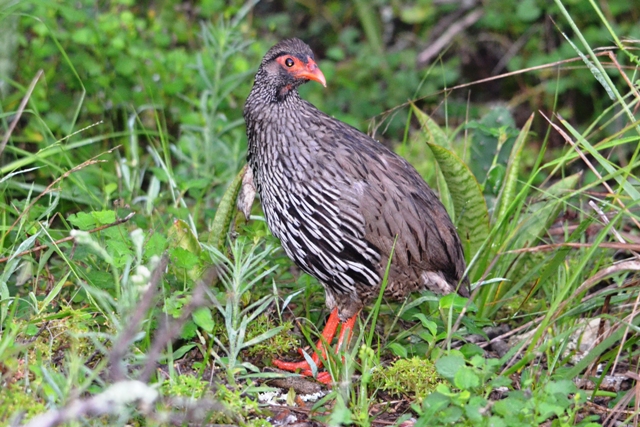 © Mel
© Mel
 © nan
© nan
Links:
Sabap2
Species Text Sabap1
Bioversity Explorer

 © Mel
© Mel © nan
© nanLinks:
Sabap2
Species Text Sabap1
Bioversity Explorer


